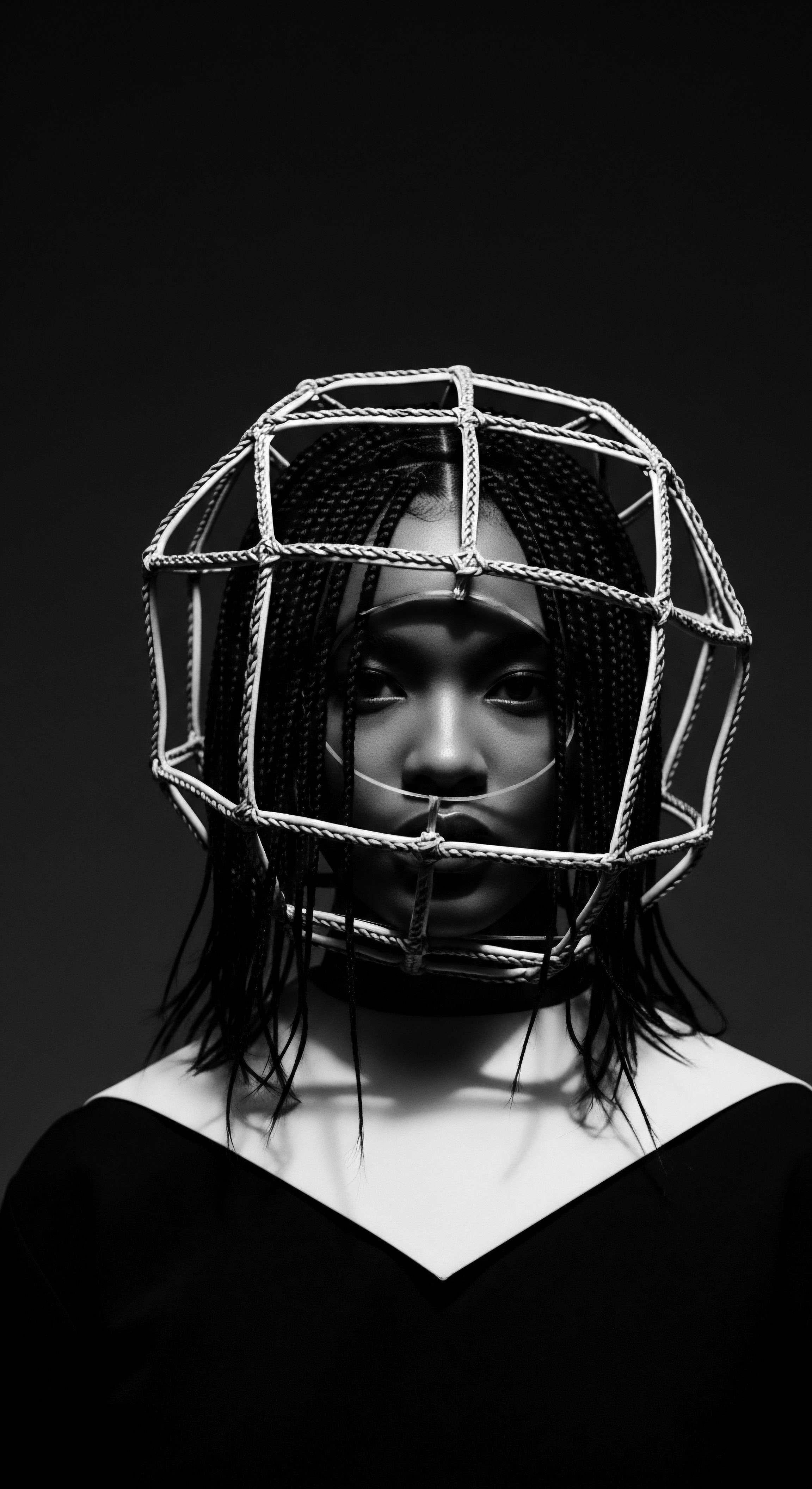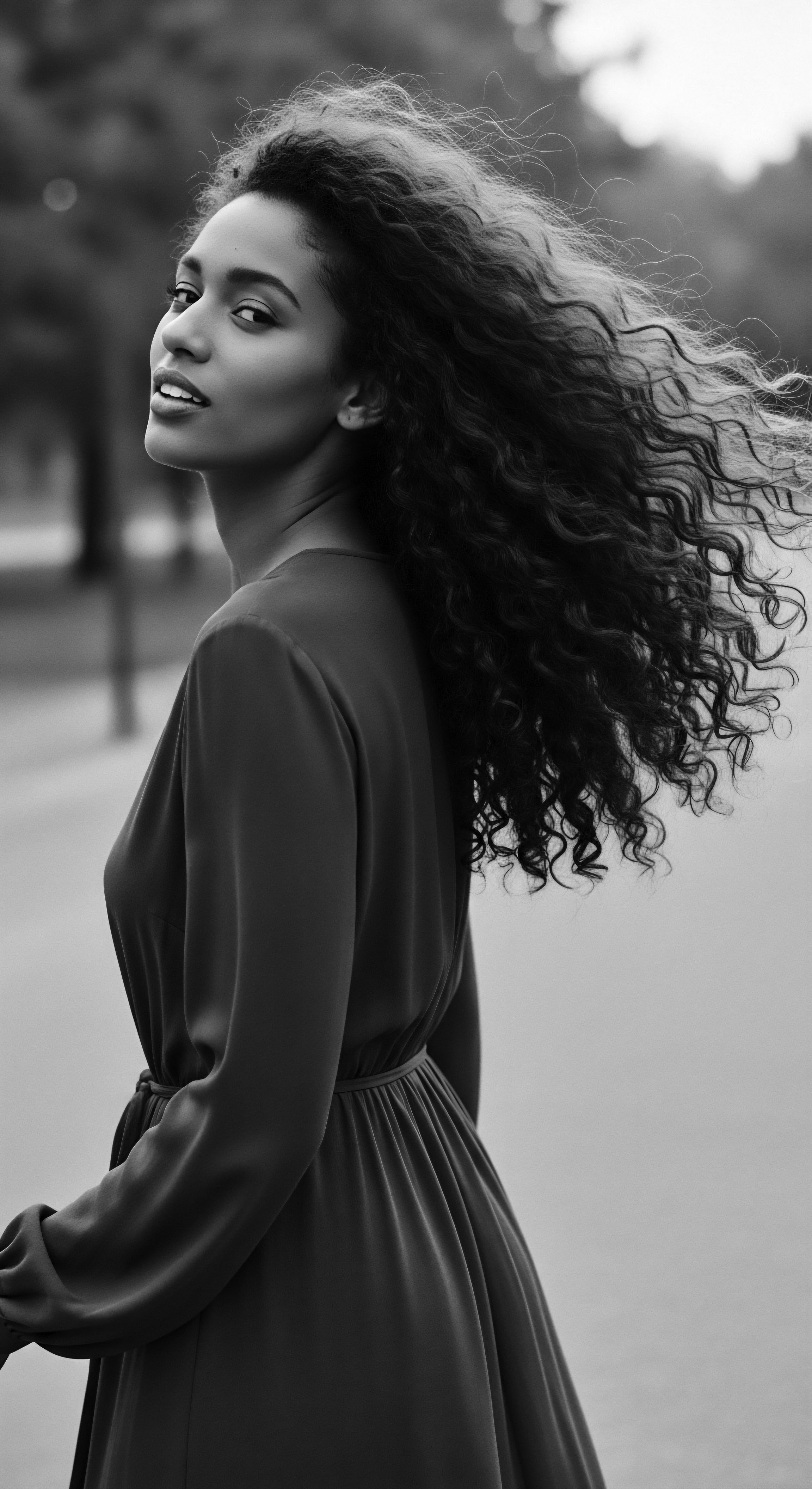
Roots
The spirit of a strand. It whispers of sun-drenched savannas and resilient hands, of ancient wisdom passed through the generations. It holds within its very architecture the memory of ancestral lands, a testament to enduring adaptation. For those with textured hair, the connection to their heritage is not merely symbolic; it is woven into the very coil and curve of each individual fiber.
We are here to understand a fundamental aspect of this legacy ❉ how the surrounding world, in its ebb and flow of warmth and chill, of dampness and aridity, speaks to the very capacity of our hair to hold onto life-giving water. This exploration is a journey into the self, a dialogue between biology and the unbroken chain of custom.

The Ancestral Architectures of Hair and Climate
To truly grasp how environmental factors shape moisture retention, we must first look to the source, the biological foundations that distinguish textured hair. Consider the intricate architecture of a single hair strand. Unlike straight or wavy hair, tightly coiled hair emerges from an elliptical follicle, curving as it grows.
This helical structure, a marvel of biological design, served a vital purpose in the often warm and humid climates where much of this hair originated. It created a natural buffer, a kind of breathable shield, offering protection from the intense solar radiation of equatorial regions while allowing air to circulate around the scalp.
This inherent design, however, also presents unique challenges when it comes to moisture. The twists and turns along the hair shaft create more points where the cuticle, the protective outer layer of the hair, can lift. Imagine a tiled roof; if the tiles are flat and overlapping perfectly, water sheds easily. If the roof has many bends and the tiles are naturally prone to slight elevation at these junctures, it becomes easier for moisture to enter, but also, paradoxically, to escape.
Scientific studies reveal that Afro-textured hair generally has a reduced number of cuticle layers compared to other hair types. For instance, some research indicates that Afro-textured hair possesses typically Three to Seven Cuticle Layers, a distinction from Asian hair, which often exhibits seven to ten layers, or Caucasian hair, with five to eight layers. This difference profoundly impacts how moisture enters and, crucially, how well it is retained within the hair fiber.
The very structure of textured hair, a heritage from ancestral climates, dictates its unique moisture dynamics in the modern world.

From Source to Strand Historic Climates and Hair’s Response
Our ancestors, living in profound harmony with their surroundings, observed these characteristics of their hair. Their hair care practices were deeply intertwined with the environmental conditions of their homelands. In the humid regions of West Africa, for instance, traditional ingredients like shea butter, coconut oil, and various plant extracts served not only to moisturize but also to protect hair from constant exposure to the elements. These substances, rich in lipids, helped seal the hair’s surface, reinforcing its natural defenses against the sun and maintaining its suppleness.
The journey across the Atlantic, however, disrupted this delicate balance. Enslaved Africans were forcibly removed from the environments that had shaped their hair’s evolutionary characteristics and the traditional care practices that sustained it. They arrived in new lands with vastly different climates, often experiencing drier air, colder temperatures, and a stark lack of familiar botanical resources. This dramatic environmental shift necessitated a fundamental re-evaluation of hair care.
The once thriving, well-maintained tresses, nurtured with specific plant oils and intricate styling methods, faced unprecedented challenges. The cruel realities of bondage, including forced shaving and the absence of traditional tools, only compounded the struggle for healthy hair.
This period saw the ingenuity of those in the diaspora, adapting what was available to preserve their hair’s integrity. Materials like animal fats, rudimentary oils, and even sheep fleece carding tools for detangling became unlikely, yet essential, elements in a new, imposed hair care regimen. These were not choices born of preference but of survival, direct responses to a harsh new environment and a deliberate cultural erasure. The environmental factor of changed climate and resource availability directly altered moisture retention challenges and the ancestral methods devised to combat them.
- Shea Butter ❉ A staple from West Africa, revered for centuries for its rich fatty acids and vitamins, offering deep conditioning and environmental protection.
- Coconut Oil ❉ Widely utilized in many tropical regions, known for its ability to penetrate the hair shaft and reduce protein loss, aiding moisture retention.
- Aloe Vera ❉ Valued for its soothing and hydrating properties, used traditionally to calm the scalp and condition hair.

Ritual
The art of caring for textured hair has always transcended simple hygiene; it is a ritual, a connection to lineage, a practice of reverence. The intricate techniques and chosen tools often reflect a deep understanding of hair’s needs within its environmental context, passed from elder to youth. Our rituals of care, whether ancient or contemporary, are intimately shaped by the environmental demands for moisture retention.

How Did Ancestral Practices Address Moisture Retention Across Climates?
Ancestral practices, whether in the humid rainforests of Central Africa or the dry desert regions, demonstrated an intuitive grasp of environmental impacts on moisture retention. In areas of high humidity, styles often prioritized airflow and protection from tangling, while still benefiting from the surrounding atmospheric moisture. Braids, twists, and locs, deeply rooted in various African cultures, served multiple purposes ❉ expressing identity, signifying status, and also managing hair effectively under diverse environmental conditions. These styles inherently offered a form of protective care, minimizing direct exposure to harsh sun and wind, both of which can accelerate moisture loss.
For those in more arid regions, traditional care leaned heavily on emollients and occlusives derived from local flora. Think of the use of specific plant butters or oils that would coat the hair shaft, creating a barrier to prevent the precious internal moisture from escaping into the dry air. The application of these natural conditioners became a daily or weekly ritual, a necessary adaptation to a parched environment. This intentional layering of protective substances mirrors modern understanding of sealing moisture, yet it was developed centuries ago through observation and communal wisdom.

Crafting Protection Historical Styling and Environmental Resilience
The evolution of styling techniques for textured hair, particularly those geared towards protection, reveals a continuous dialogue with the environment. Protective styles, such as cornrows, Bantu knots, and various forms of braiding, were not only aesthetic expressions but strategic defenses against environmental stressors. These styles reduced direct exposure of individual hair strands to sunlight, wind, and low humidity, minimizing mechanical damage and aiding in moisture preservation. For instance, the Mbalantu women of Namibia created elaborate, elongated braids (eembuvi braids) that not only symbolized their societal standing but also likely offered a practical means of managing and preserving hair integrity in their environment.
The ingenuity extended to the tools themselves. While modern hairstyling offers a plethora of implements, many are contemporary iterations of ancestral designs. The classic Afro Pick, for example, has historical parallels to the long-toothed wooden combs used in ancient African societies, designed to navigate dense, coily textures without causing excessive breakage, which can compromise the cuticle and lead to moisture loss.
Willie L. Morrow, a pioneer in Black hair care, introduced a mass-produced Afro pick in the 1960s, drawing inspiration from these traditional African combs.
Traditional styling, a practice steeped in heritage, offered both cultural expression and practical defense against environmental moisture challenges.
Consider the contrast between hair that is left unbound in a dry, windy climate and hair meticulously braided and adorned. The latter, by virtue of its bundled configuration, experiences less surface area exposure to moisture-stripping elements. This is not just an aesthetic choice; it is a profound historical understanding of how to work with the hair’s inherent nature and the surrounding world.
| Traditional Practice Application of natural plant butters (e.g. Shea, Cocoa) |
| Modern Parallel or Understanding Use of leave-in conditioners and heavy creams to seal in moisture. |
| Traditional Practice Intricate braiding and twisting styles (e.g. Cornrows, Bantu Knots) |
| Modern Parallel or Understanding Protective styling to minimize manipulation and exposure to elements. |
| Traditional Practice Use of natural oils (e.g. Coconut, Castor) as sealants |
| Modern Parallel or Understanding Layering oils (LOC/LCO method) to lock in hydration. |
| Traditional Practice Headwraps and scarves for daily adornment and protection |
| Modern Parallel or Understanding Silk or satin bonnets and scarves for nighttime protection and moisture retention. |
| Traditional Practice These interwoven approaches highlight how heritage wisdom often aligns with contemporary scientific insights on hair moisture. |

Relay
The wisdom passed through generations, the scientific discoveries, and the lived experiences of those with textured hair converge in a continuous relay. It is a transmission of knowledge, adapting and deepening our comprehension of environmental factors and moisture retention, always through the profound lens of heritage. This segment analyzes the complexities with a detailed approach, drawing upon research and cultural insights.

How Does Ambient Humidity Directly Affect Textured Hair Moisture?
The air surrounding us holds a specific amount of water vapor, known as ambient humidity. This environmental factor directly interacts with the hair’s capacity to retain moisture. In highly humid environments, textured hair often experiences increased water absorption, as the hair tries to reach equilibrium with the moisture in the air.
This can lead to the cuticle lifting slightly, resulting in frizz and potential tangling. While some humidity might seem beneficial for dryness, excessive humidity can compromise the hair’s structural integrity over time, making it more prone to hygral fatigue, a state of weakened hair due to repeated swelling and shrinking from water absorption and desorption.
Conversely, in environments characterized by low humidity or dry air, textured hair faces a significant challenge. The hair, with its naturally raised cuticles and lower inherent hydration levels, is more susceptible to moisture loss. Water molecules within the hair fiber readily evaporate into the drier atmosphere, leaving the strands feeling brittle, rough, and prone to breakage.
This is particularly noticeable in colder climates during winter, where indoor heating further strips the air of moisture. Individuals of African descent, whose hair is adapted to generally warmer, more humid ancestral environments, often report increased dryness and vulnerability in such conditions.
A study on the influence of hair lipids in ethnic hair properties showed that while African hair exhibits the highest total lipid content, much of this is from external sebaceous lipids, and it paradoxically shows lower intrinsic moisturization and reduced radial swelling in water compared to Asian or Caucasian hair. This suggests a unique interplay between lipid composition, structural properties, and moisture dynamics, making textured hair particularly responsive to environmental shifts. (Loussouarn et al. 2023)

Can Environmental Pollutants Influence Hair’s Hydration Capacity?
Beyond humidity and temperature, less obvious environmental aggressors, like pollutants and ultraviolet (UV) radiation, exert a subtle yet significant influence on hair’s moisture retention. Airborne pollutants, including dust, smoke, and various chemical particles, can settle on the hair shaft and scalp. These particles may contribute to oxidative stress, potentially damaging the cuticle layer.
When the cuticle is compromised, its ability to lie flat and seal moisture within the hair fiber diminishes. This can lead to increased porosity, meaning hair more readily absorbs and loses water, ultimately resulting in chronic dryness.
UV radiation from the sun, particularly prolonged exposure, can degrade the hair’s protein structure. The melanin in darker hair provides some natural protection, a remnant of its evolutionary role in sun-rich environments. However, even with this defense, cumulative UV damage can weaken the hair, making it more porous and less able to retain moisture.
This degradation can lead to a rougher cuticle surface, further exacerbating water loss. Historically, ancestral practices involving head coverings, such as scarves and elaborate wraps, often served as an intuitive shield against intense sun exposure, mitigating this environmental assault on hair health.

Understanding the Microclimate Around the Strand
The concept of a microclimate, the very immediate environment surrounding each hair strand, helps explain localized moisture dynamics. This microclimate is influenced by the macro-environment, certainly, but also by internal factors like scalp sebum production and individual styling choices. Textured hair, due to its coily nature, often experiences uneven distribution of sebum from the scalp along the hair shaft.
This means that while the scalp might produce sufficient oils, the ends of the hair, being further from the source, tend to be drier. This intrinsic characteristic makes textured hair inherently more vulnerable to moisture loss in dry environmental conditions.
The pH of the environment, whether from water used for cleansing or products applied, also plays a critical role. Hair and scalp thrive in a slightly acidic environment (around pH 4.5-5.5), which helps keep the cuticle layers flat and sealed. Exposure to highly alkaline substances or harsh water can cause the cuticle to lift, leading to increased porosity and a compromised ability to hold onto moisture. This scientific understanding validates ancestral practices that sometimes utilized acidic rinses, like fermented rice water or fruit extracts, which unknowingly helped restore the hair’s optimal pH balance.
- Cuticle Integrity ❉ Environmental factors like pollution and UV radiation can compromise the cuticle, leading to increased porosity and moisture evaporation.
- Sebum Distribution ❉ The natural coily structure of textured hair can hinder even sebum distribution, leaving hair ends more susceptible to environmental dryness.
- PH Balance ❉ The hair’s optimal slightly acidic pH helps keep cuticles flat, sealing in moisture, a principle often supported by traditional rinses.
| Environmental Factor Humidity (High) |
| Impact on Moisture Retention Can cause frizz, hygral fatigue, and uneven moisture absorption/loss. |
| Heritage/Scientific Link Ancestral adaptive styles for humid climates, understanding hair's "breathability." |
| Environmental Factor Humidity (Low/Dry Air) |
| Impact on Moisture Retention Leads to rapid moisture evaporation, dryness, and brittleness. |
| Heritage/Scientific Link Diasporic adaptations to new climates, use of emollients and occlusives. |
| Environmental Factor UV Radiation |
| Impact on Moisture Retention Degrades protein structure, increases porosity, and reduces strength. |
| Heritage/Scientific Link Traditional use of headwraps and natural emollients for sun protection. |
| Environmental Factor Pollution |
| Impact on Moisture Retention Deposits particles, causes oxidative stress, and damages cuticle. |
| Heritage/Scientific Link Modern environmental justice considerations, historic purity of natural ingredients. |
| Environmental Factor Water Quality (pH) |
| Impact on Moisture Retention Alkaline water lifts cuticles, leading to moisture loss; acidic water flattens them. |
| Heritage/Scientific Link Ancestral use of acidic rinses (e.g. rice water) to balance hair pH. |
| Environmental Factor Understanding these dynamics allows for informed care, bridging ancient wisdom with contemporary science to preserve hair's vitality. |

Reflection
The journey through the intricate relationship between environmental factors and moisture retention in textured hair is more than a scientific inquiry; it is a profound meditation on heritage. It reveals how the very design of textured hair is an echo of its ancestral origins, shaped by climates and cultures, a living archive of resilience. The strand itself holds stories of adaptation, struggle, and the enduring power of ingenuity.
We see that the hair, in its responsiveness to the world around it, carries forward the wisdom of those who came before us. Their intimate knowledge of natural ingredients, their meticulous styling techniques, and their careful protection rituals were not accidental. They were sophisticated responses to environmental demands, intuitive scientific understandings passed down through the ages.
These ancestral practices, whether born of necessity in the face of forced displacement or cultivated in harmony with rich ecosystems, laid the groundwork for our contemporary understanding of hair care. They remind us that our hair is not simply a physical attribute but a cherished connection to a vibrant cultural legacy.
As we navigate today’s diverse environments, from arid cityscapes to humid coastal regions, the challenges to moisture retention persist. Yet, within these challenges lies an invitation to deepen our connection to our heritage. We can draw upon the collective wisdom of our forebears, integrating time-honored practices with the clarity offered by modern science.
It is a call to recognize the enduring intelligence of traditional methods, to honor the historical struggles that forged resilience in hair care, and to celebrate the unique beauty that has persevered through every climate and circumstance. The soul of a strand, indeed, continues to whisper its powerful story of enduring beauty and adaptive grace, urging us to listen, to learn, and to carry its legacy forward with reverence and informed care.

References
- Byrd, Ayana D. and Lori L. Tharps. Hair Story ❉ Untangling the Roots of Black Hair in America. St. Martin’s Press, 2001.
- Loussouarn, Geneviève, et al. “The influence of hair lipids in ethnic hair properties.” International Journal of Cosmetic Science, vol. 45, no. 1, 2023, pp. 1-10.
- Morrow, Willie L. 400 Years Without a Comb. Morrow’s Unlimited, 1973.
- Okoro, N. et al. “Historical Perspectives on Hair Care and Common Styling Practices in Black Women.” Journal of Drugs in Dermatology, vol. 24, no. 3, 2025, pp. 273-277.
- “Hair Porosity and Race ❉ How Climate Shaped Afro vs Straight Hair.” YouTube, published by Nappyfro LLC, 11 Apr. 2025.
- Tabora A. Johnson and Teiahsha Bankhead. Hair It Is ❉ Examining the Experiences of Black Women with Natural Hair. Claremont Colleges Scholarship. 2023.
- Westgate, G. E. et al. “The what, why and how of curly hair ❉ a review.” Experimental Dermatology, vol. 28, no. 12, 2019, pp. 1381-1390.
